How to Get Rid Of Skunks
52 min read Updated for December, 2019
Skunks are one of the most recognizable animals due to their signature black fur and large white stripe or V that runs down their back. They are equally known for the noxious odor they emit from their anal glands when threatened. While easy to spot, skunks are not often observed by humans because like so many mammals, they are nocturnal, meaning that they are most active at night.
Skunks are typically considered a beneficial species because they consume a lot of insects and rodents. They pose little threat to humans because they are not aggressive and will not harm humans unless they are under attack. However, they become a nuisance when their burrowing or feeding habits conflict with yours. Skunks carry diseases and can cause a lot of damage and discomfort if they find a home on your property, so it is best to relocate them if you find yourself in this situation.
If you suspect a skunk may be the cause of damage on your property, the first step is to confirm its identity so you can move forward in exploring options for removal and control.
52 min read Updated for December, 2019

Skunk Sounds
Skunks are generally quiet animals, but they do use sounds to communicate using squeals, growls, hisses, and even a cooing sound. They are known to stomp their front feet when especially angry or threatened, grumble when upset, and smack their lips when content.
Skunk Tracks
Skunks have five toes on their front and hind paws; the front feet have long claws which are clearly notated by a dot much further ahead of the toes. The hind paws have a larger heel pad which shows up long and rectangular in shape. Skunks travel in a variety of gaits and while moving slowly—searching for food—often overstep their tracks.
Skunk Poop
Skunk poop is similar to cat droppings, just not as well formed, though still tubular with blunt ends and measure an inch to two inches long and about a quarter to half an inch in diameter. As omnivores, you’ll find berries, undigested insects, and maybe even fur or feathers in the poop. You’ll typically find these dropping in lawns and gardens.
Identify
Physical Characteristics
Skunks are members of the weasel family, so they are related to river otters, badgers, mink, and of coarse weasels. In general, they have short, stocky legs and large feet with long hooked claws. Striped skunks are the most common and most widely recognized species. They have been dubbed polecats due to the signature white stripe that runs down their backs. They also have a bar of white fur between their eyes. While some species of North American skunks have less graphic markings, all species are black and white in color, and most are roughly the size of a house cat or smaller. Their long, bushy tails usually account for the majority of their body length.
Common Species
While there are a total of 12 species of skunks, there are only four that reside in North America. The striped skunk is the iconic species that most people can readily identify, but here is a comprehensive description of each species:
Striped Skunk
- Approximately the size of a house cat
- Short, stocky legs with large feet
- Black fur with a white V that runs down their back
- Long, bushy tail of white and black fur
- Small triangular head with little ears
- Short legs, webbed toes, and long claws
- Found in every state in the U.S.
Eastern Spotted Skunk
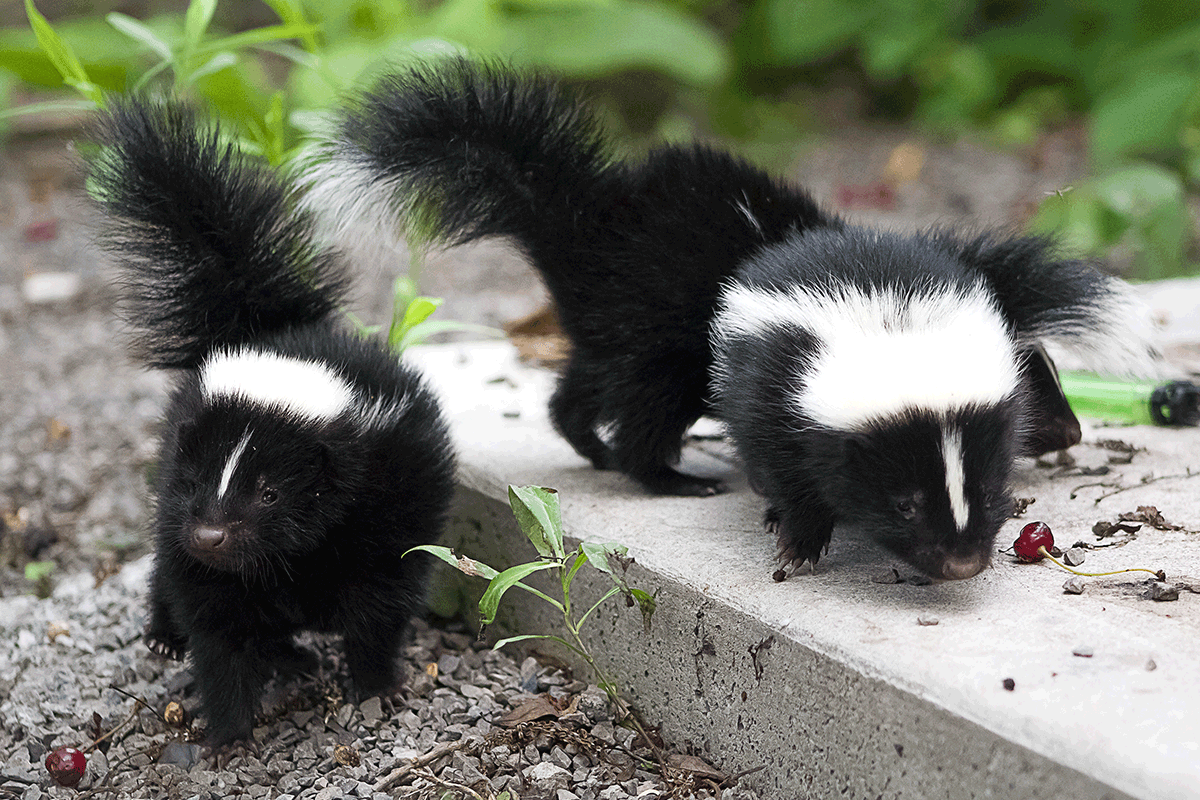
- Closer in size to a tree squirrel
- Six distinct white stripes on the back and two white bands on each side of the rump
- Front claws are more than twice as long as back claws
- The only member of skunk family that can climb
- Found throughout much of the Eastern U.S., as far North as Minnesota, and even in the Midwest
Hooded Skunk
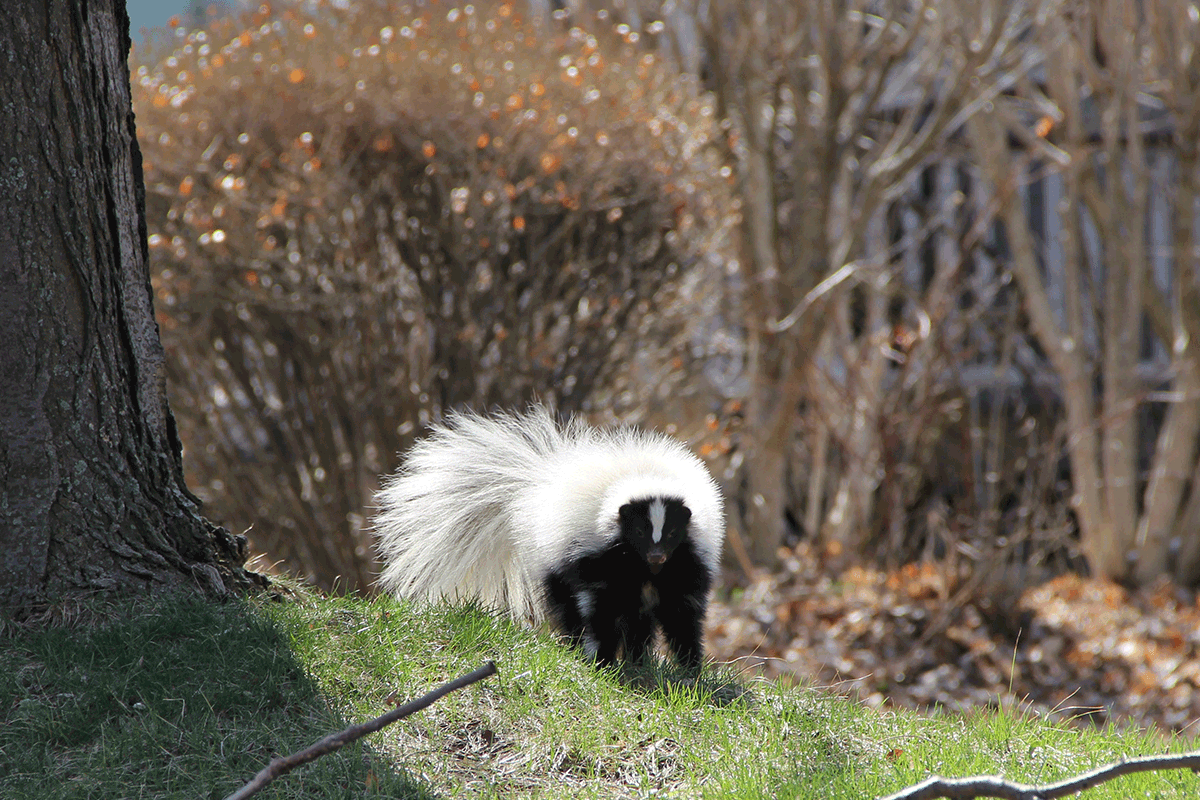
- Smaller and leaner than a striped skunk, they typically weigh about five pounds
- Three colorations: black-backed, white-backed, or all black
- Long hair on the back of their neck and head give them a hooded appearance
- Nocturnal, solitary, and slow moving
- They live primarily in the southwest U.S.
Hog-Nosed Skunk
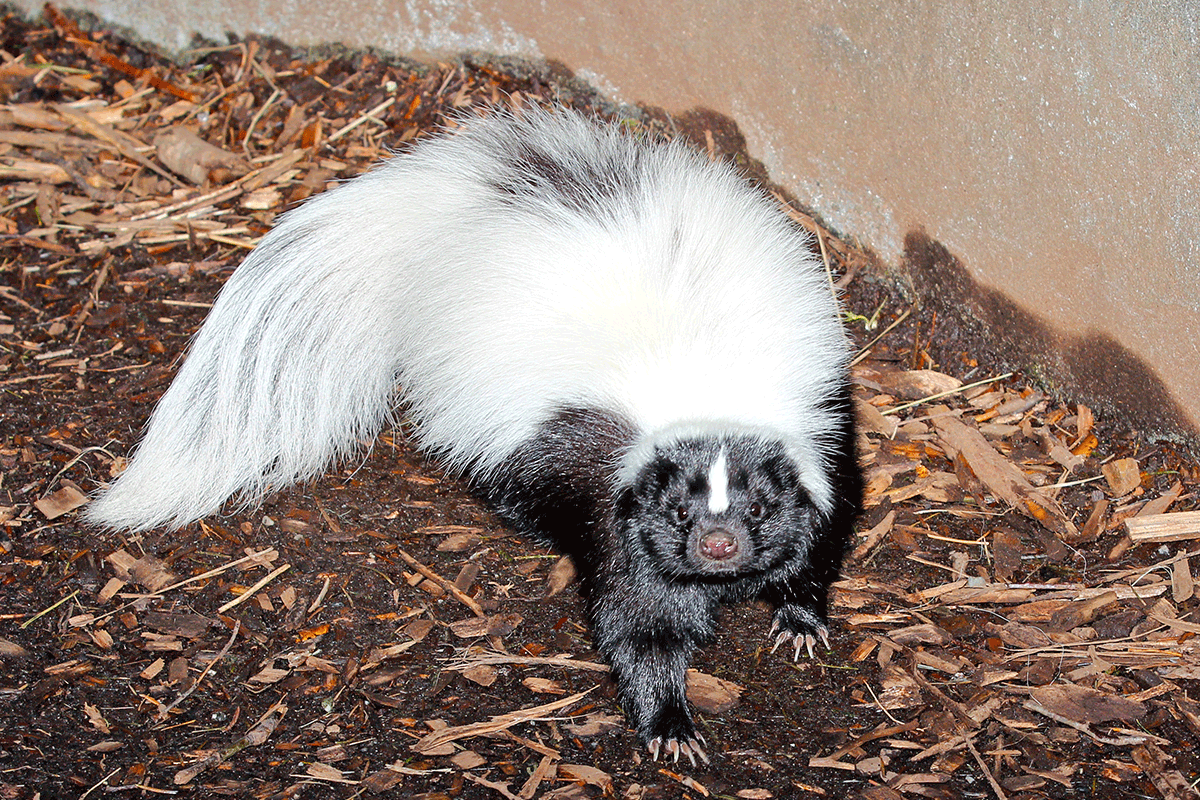
- Largest North American species at about three feet in length
- The tail is considerably shorter than other species
- More limited diet that consists primarily of insects
- The underside of their body is black, and a thick, single white stripe covers their back
- Their tails are all white
- Their defining feature is their broad, hairless nose
- They live primarily in Southeast Texas
Common Locations
The striped skunk has the broadest geographic range and can be found across the continental U.S.. The Eastern spotted skunk is found primarily in the Eastern U.S., but they are sometimes located as far west as Colorado and throughout the Midwest. Though their range is broad, they are far less populous. The species has experienced a continued decline in numbers since the 1940s and are even considered a species of high conservation concern in some states. Hooded and Hog-Nosed Skunks can be found in much smaller geographic areas, making them much more elusive.
Treating Your Property For Skunks
There are several products that you may find useful and necessary if you have a skunk living on or around your property. From odor removers, repellents, bait, and traps, here are few products on Amazon.com to consider.
Repellents
Bait
DIY treatments
Vinegar
If you or your pet come into the house after being sprayed by a skunk, the odor will most certainly linger in your home for quite some time To get rid of it, boil vinegar in a pan. Your house will smell like vinegar for a while, but once that dissipates, so will the skunk odor.
Bleach
To get the skunk smell out of a building or off of an outdoor surface like a porch or deck, mix 1 cup of liquid bleach with one gallon of water and clean the surface with it.
Tomato Juice
This is a well-known, old-time remedy for de-skunking your pet. Make sure to bathe them in tomato juice outdoors to get rid of most of the smell before bringing them back inside.
Vanilla Extract
Mix one cup of vanilla extract with a gallon of water and completely cover your dog or pet with the mixture. Let them soak for at least ten minutes before shampooing and rinsing.
Apple Cider Vinegar
Mix two parts water with one part apple cider vinegar. Wet your pet’s fur and apply the mixture carefully, making sure to rub it thoroughly into the fur. Let your pet soak in the mix for about five minutes before rinsing. Make sure not to get the mixture in his/her eyes as it will sting.
Skunk Problem?
Skunks, in general, are highly adaptable animals that can live and thrive in a wide variety of habitats.
Skunks, in general, are highly adaptable animals that can live and thrive in a wide variety of habitats. They favor pastures, clearings, and open land that borders on forests, although some species live in deserts and mountains. More commonly, skunks will take over abandoned burrows that were created by other animals, but will also live in abandoned buildings, hollow logs, brush piles, and under large rocks. Because they do not travel more than one to two miles from their dens, skunks will invariably live near a water source.
While skunks tend to have poor eyesight, they have a very keen sense of smell. So if you do find a skunk on your property, open trash cans, compost heaps, pet food, or litter boxes are often what lead them there. They are very opportunistic animals, so a present food source or existing burrow are both attractants.
It’s not unheard of for skunks to make a den underneath a porch or in a crawl space, which can be very destructive for you, the homeowner. They have very sharp claws used to dig and forage for food, which may lead to damaged ventilation and even worse, a compromised foundation. Further discomfort can result when a skunk sprays while on your property. The oily spray they emit from their anal glands is extremely difficult to remove from fabric and surfaces, and can lead to a costly and time-consuming clean up if it gets into your house.
Skunk Sounds
Skunks are generally quiet animals, but they do use sounds to communicate using squeals, growls, hisses, and even a cooing sound. They are known to stomp their front feet when especially angry or threatened, grumble when upset, and smack their lips when content.
Skunk Tracks
Skunks have five toes on their front and hind paws; the front feet have long claws which are clearly notated by a dot much further ahead of the toes. The hind paws have a larger heel pad which shows up long and rectangular in shape. Skunks travel in a variety of gaits and while moving slowly—searching for food—often overstep their tracks.
Skunk Poop
Skunk poop is similar to cat droppings, just not as well formed, though still tubular with blunt ends and measure an inch to two inches long and about a quarter to half an inch in diameter. As omnivores, you’ll find berries, undigested insects, and maybe even fur or feathers in the poop. You’ll typically find these dropping in lawns and gardens.
Inspect
Should I Relocate This Animal?
While skunks rarely cause considerable damage and are even deemed beneficial because they control insects and pests that tend to damage crops and agriculture, there are certainly many reasons to consider relocation if one is living on or around your property.
Disease
Skunks carry a variety of contagious diseases and parasites that are dangerous to both humans and pets.
Damage
Skunks are notorious diggers, which can lead to minor issues like holes in your lawn to more severe property damage. If you live on a farm, you’ll have to weigh the damage they reap against the benefit of them eating insects that are common threats to agriculture. They can damage corn by feeding on the lower ears and will also raid chicken houses for the eggs and sometimes even prey on poultry.
The good news is that it is possible to live trap and relocate a skunk without having to encounter their noxious spray and without harming the animal. And because skunks are not territorial, it is like that they will not return once removed. Live trapping is the most environmentally friendly method for removing a skunk. Having said that, it is imperative that you contact your local game commission or humane society for laws and information that pertain to the trapping and release of wild animals. State regulations dictate the legality of trapping, types of traps that are allowed, and guidelines for releasing the animal.
Gather the Tools You’ll Need
Trap
Complete a thorough investigation of your choices online before purchasing as there are many options.
Bait
You can use bait that you find in your homes like a piece of meat, cat food, or peanut butter. You can also purchase bait specifically for skunks.
Sheet
If you have a wire trap, you will want to drape a sheet over it to prevent the skunk from spraying.
Gloves
Skunks have incredibly long and sharp claws, so it is essential to protect your hands when handling the trap.
Plastic Bag
Make sure to place the trap on a plastic bag when transporting it to protect your car seats.
Plastic Bag
Make sure to place the trap on a plastic bag when transporting it to protect your car seats.
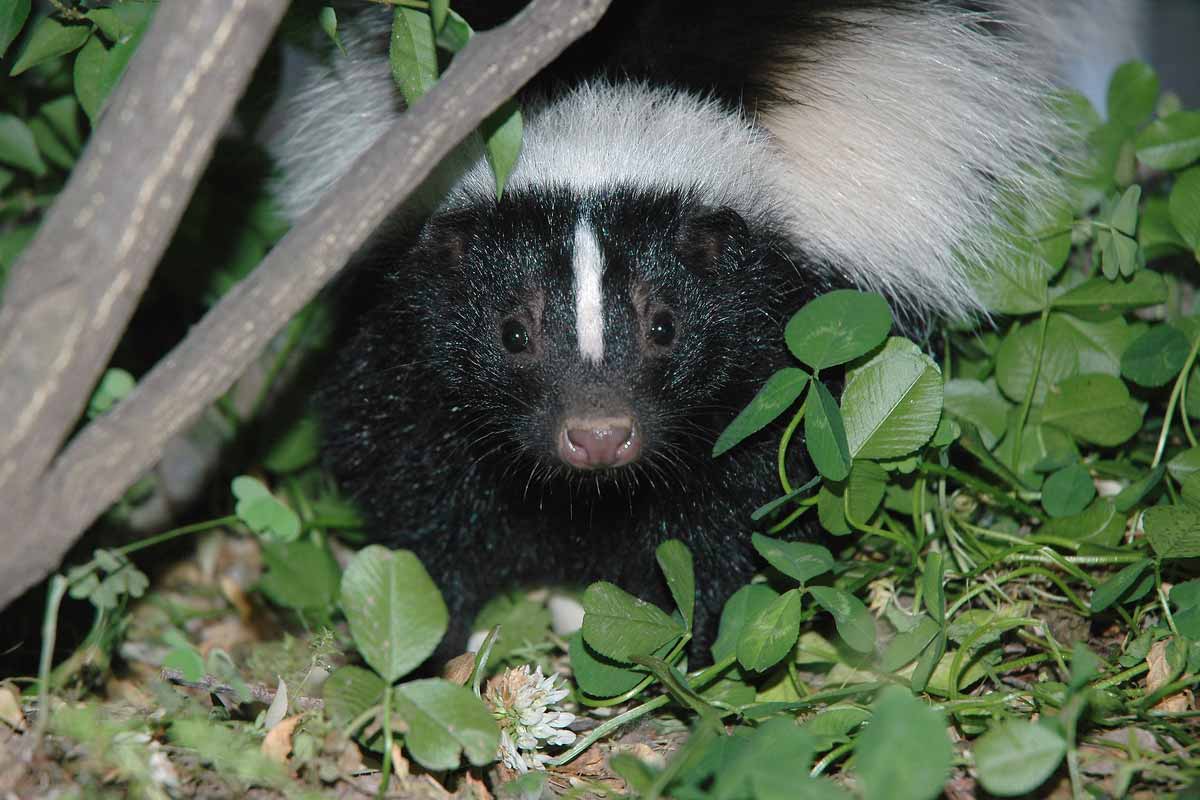
How-to Steps For DIY Removal
Select a trap
If you are not a professional, it’s in your best interest to select a trap that allows you to release the animal from a distance, thus avoiding unnecessary contact. You will want to decide between a one or two door model, though skunks are more likely to enter a one-door trap fully. Also, there are spray-proof traps, which would be beneficial in case the animal becomes alarmed and sprays.
Determine trap location
Place your trap near the area you have observed the most damage from the skunk. If you know where its den is, place the trap five to 10 feet from the entrance.
Bait your trap
It is important to place the bait in a way that will get the skunk to enter the trap fully while at the same time stepping on the trigger plate.
Set the trap
Since skunks are nocturnal, set the trap at dusk and make sure to close it in the morning if the trap is empty and reset it again that evening.
Monitor your trap
It is important to pay close attention to any activity to ensure that a trapped animal doesn’t remain in the trap for longer than necessary.
Treating Your Property For Skunks
There are several products that you may find useful and necessary if you have a skunk living on or around your property. From odor removers, repellents, bait, and traps, here are few products on Amazon.com to consider.
Repellents
Bait
DIY treatments
Vinegar
If you or your pet come into the house after being sprayed by a skunk, the odor will most certainly linger in your home for quite some time To get rid of it, boil vinegar in a pan. Your house will smell like vinegar for a while, but once that dissipates, so will the skunk odor.
Bleach
To get the skunk smell out of a building or off of an outdoor surface like a porch or deck, mix 1 cup of liquid bleach with one gallon of water and clean the surface with it.
Tomato Juice
This is a well-known, old-time remedy for de-skunking your pet. Make sure to bathe them in tomato juice outdoors to get rid of most of the smell before bringing them back inside.
Vanilla Extract
Mix one cup of vanilla extract with a gallon of water and completely cover your dog or pet with the mixture. Let them soak for at least ten minutes before shampooing and rinsing.
Apple Cider Vinegar
Mix two parts water with one part apple cider vinegar. Wet your pet’s fur and apply the mixture carefully, making sure to rub it thoroughly into the fur. Let your pet soak in the mix for about five minutes before rinsing. Make sure not to get the mixture in his/her eyes as it will sting.
Skunk Problem?
Skunks are not territorial and will typically not return once removed, so there is no need to take it an excessive distance.
Relocate the skunk
Once you’ve caught your skunk, approach the trap slowly to avoid startling the animal. Pick it up very slowly and carefully transport it to your vehicle. Be aware of your local laws and understand how far you can move the animal. Skunks are not territorial and will typically not return once removed, so there is no need to take it an excessive distance. Ten miles should be sufficient as long as the law permits it.
Risks Of Disease
Skunks do carry a variety of infectious diseases and parasites that can be transmittable to humans and pets. Below is a list of the most serious illnesses that they carry.
Diseases people can catch:
- Leptospirosis is a bacterial disease spread to humans and pets exposed to water, soil, and food that has been contaminated with the urine of an infected animal.
- Humans can contract tularemia after a bite, scratch, or contact with feces or urine.
Conditions that are transferable to domestic pets:
- Canine Distemper is transmitted to pets when they come into contact with the feces or urine of the infected skunk.
- Canine Hepatitis
- Intestinal Roundworm and Ringworm
- Rabies
- Aleutian Disease
According to the Humane Society, skunks are one of four wild animal species known to be primary carriers of rabies, which can be fatal to both humans and pets. There are two forms of rabies to be aware of in Skunks. The first form is known as the ‘furious’ form leading to an aggressive and dangerous animal. The second is known as the ‘dumb’ form which presents as an animal that is seemingly unaware and unaffected by human presence. If you suspect that a skunk may be rabid, do not approach that animal and call animal control immediately.
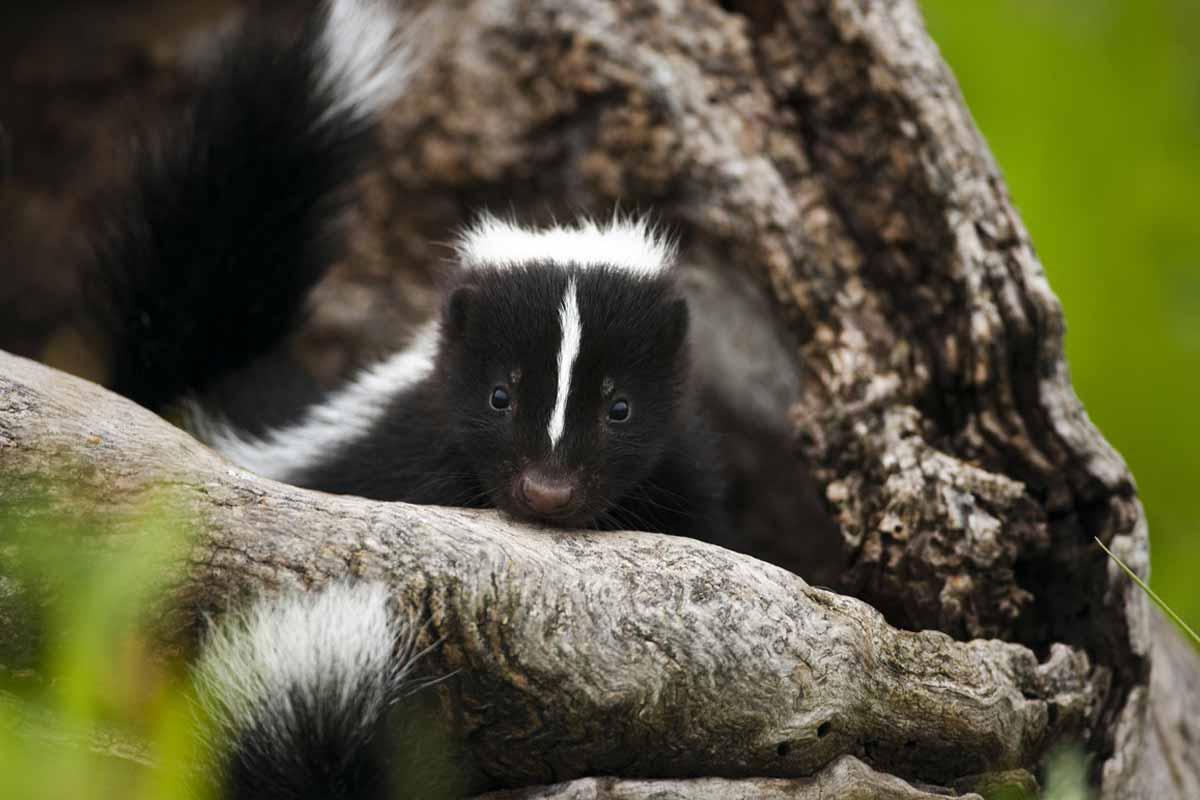
Skunk Sounds
Skunks are generally quiet animals, but they do use sounds to communicate using squeals, growls, hisses, and even a cooing sound. They are known to stomp their front feet when especially angry or threatened, grumble when upset, and smack their lips when content.
Skunk Tracks
Skunks have five toes on their front and hind paws; the front feet have long claws which are clearly notated by a dot much further ahead of the toes. The hind paws have a larger heel pad which shows up long and rectangular in shape. Skunks travel in a variety of gaits and while moving slowly—searching for food—often overstep their tracks.
Skunk Poop
Skunk poop is similar to cat droppings, just not as well formed, though still tubular with blunt ends and measure an inch to two inches long and about a quarter to half an inch in diameter. As omnivores, you’ll find berries, undigested insects, and maybe even fur or feathers in the poop. You’ll typically find these dropping in lawns and gardens.
Prevent
If you have had skunks on your property before, it is essential to take measures to prevent them from showing up again. If you have seen them near your property, it would also be in your best interest to employ these methods to keep them from causing damage or being a health hazard to you and your family. These methods are all easy, reasonably low-cost, and very effective.
Prevention Methods
Add Light
This is a simple and extremely effective method for getting rid of a lot of nocturnal creatures that tend to be a nuisance, including skunks. There are a number of products that produce flashes of light when their motion sensor is triggered. This will affect the animal’s safety instincts and send them running. Adding light is a preferred method because it is easy, inexpensive, environmentally friendly, and very effective.
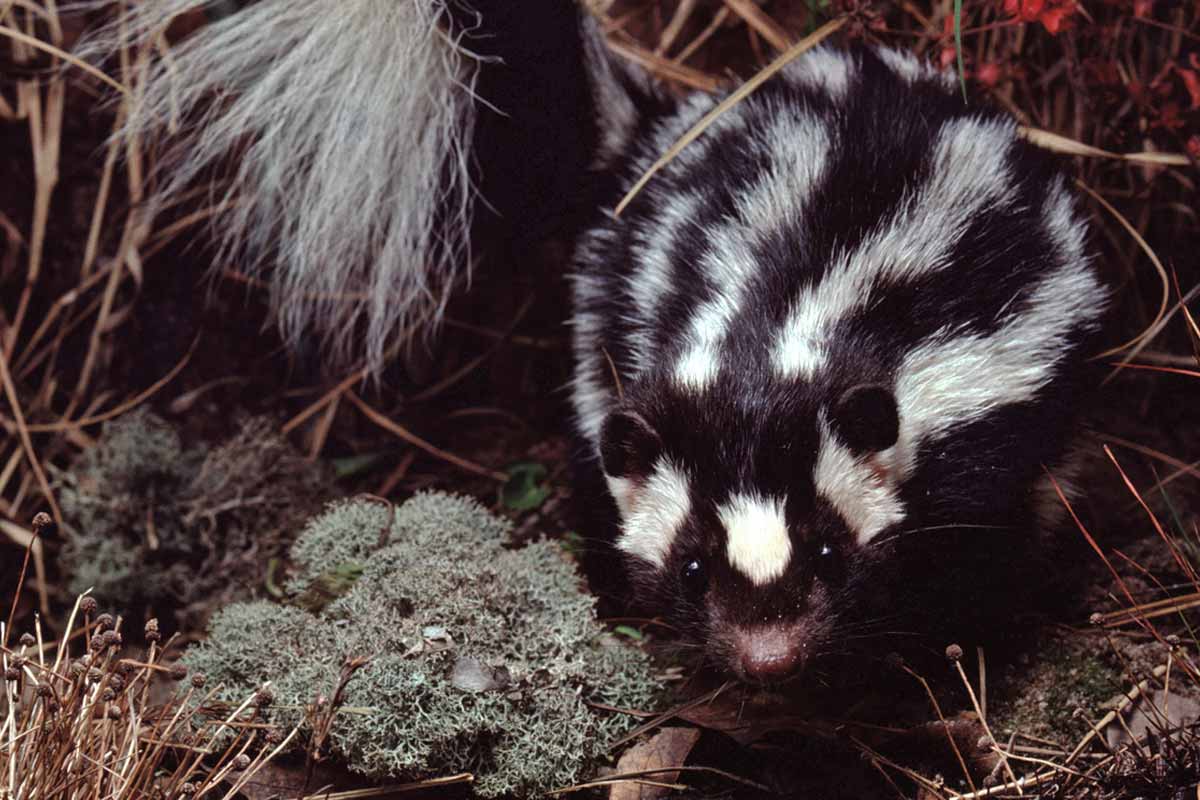
Install an exclusion barrier
Skunks are opportunistic creatures by nature and will make a den under crawl spaces, porches, sheds, and decks. Install an exclusion barrier, like wire fencing or latticework, around the perimeter to prevent them from getting in.
Reduce attractants on your property
Skunks have a very good sense of smell and are most often drawn to open garbage cans. Open litter boxes and pet food can also attract skunks, so make sure outdoor containers are tightly sealed, especially at night.
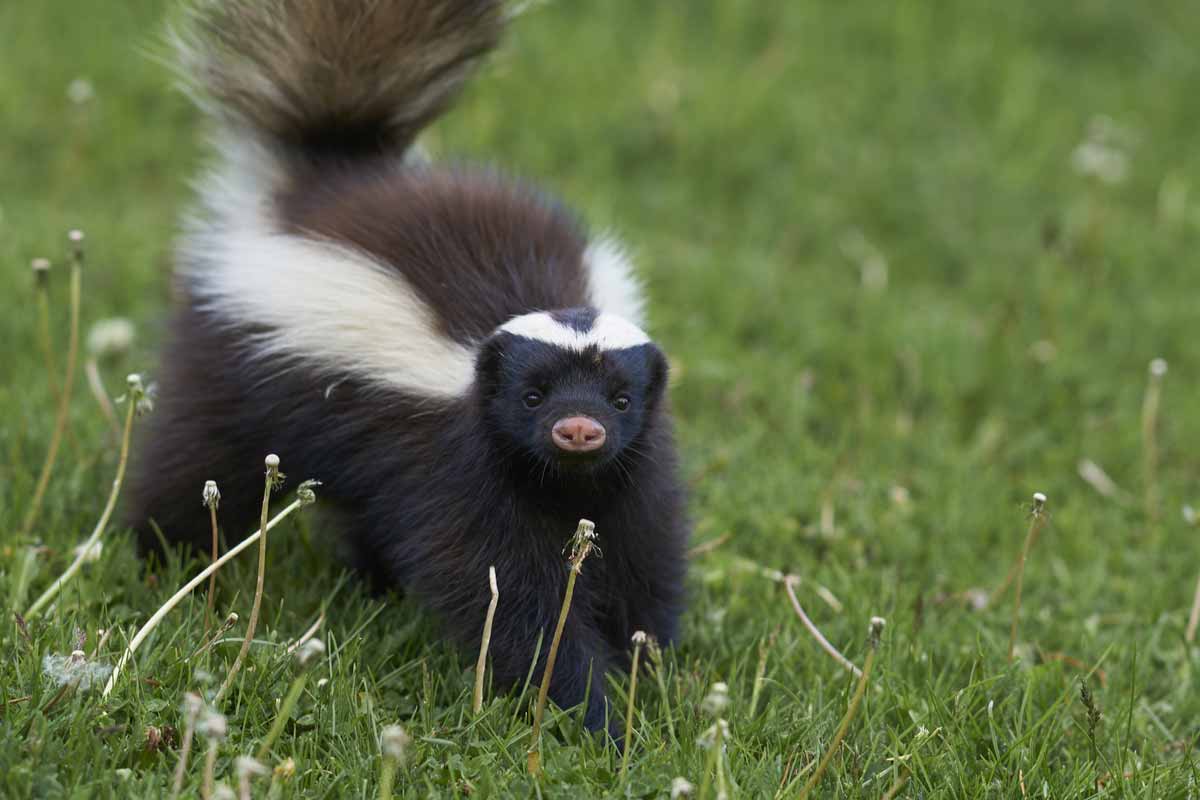
Seal their holes
Animals have powerful safety instincts and will not return to an area where their holes have been closed off. Sealing holes is also an effective way to get them to evacuate an area so that you can live trap them if that is your plan. But often, sealing off their holes alone is enough to keep them away.
Install motion-activated sprinklers
There are a lot of skunk repellents on the market, but the most effective way to administer them is through the use of a sprinkler that sprays the scent automatically when triggered by the proper range of motion.
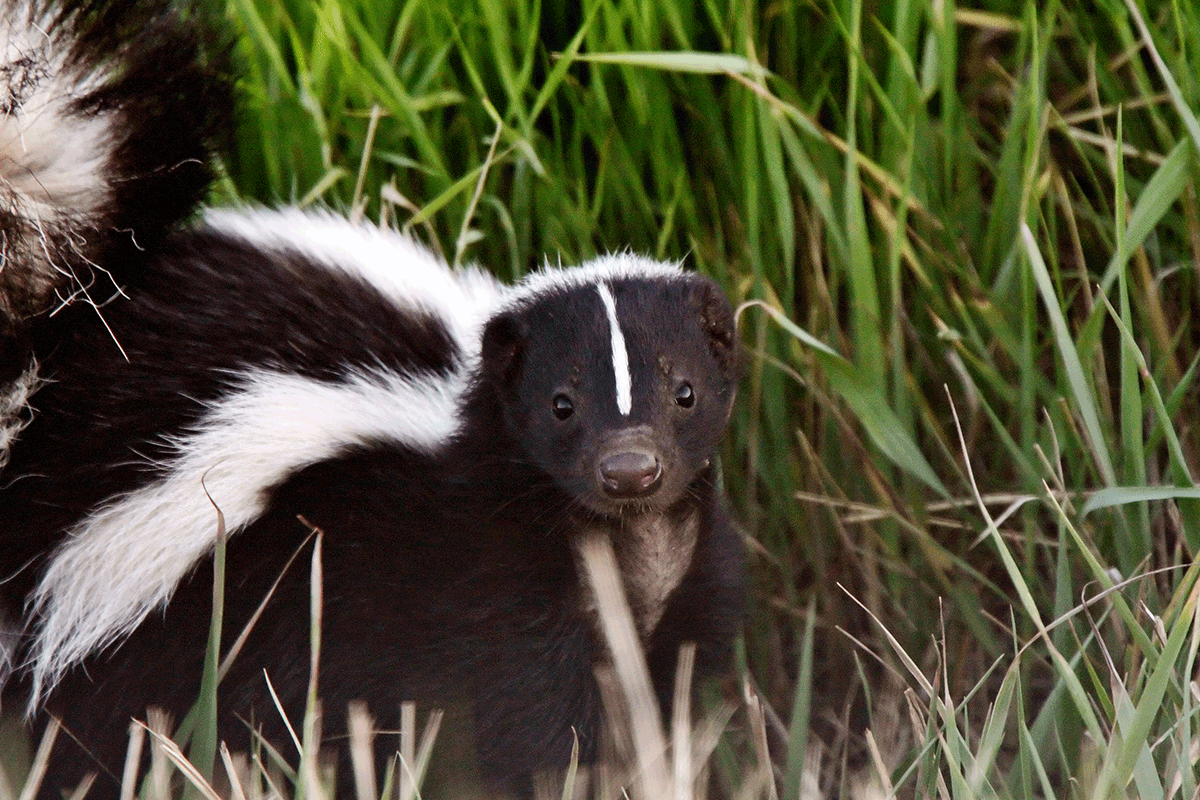
Treating Your Property For Skunks
There are several products that you may find useful and necessary if you have a skunk living on or around your property. From odor removers, repellents, bait, and traps, here are few products on Amazon.com to consider.
Repellents
Bait
DIY treatments
Vinegar
If you or your pet come into the house after being sprayed by a skunk, the odor will most certainly linger in your home for quite some time To get rid of it, boil vinegar in a pan. Your house will smell like vinegar for a while, but once that dissipates, so will the skunk odor.
Bleach
To get the skunk smell out of a building or off of an outdoor surface like a porch or deck, mix 1 cup of liquid bleach with one gallon of water and clean the surface with it.
Tomato Juice
This is a well-known, old-time remedy for de-skunking your pet. Make sure to bathe them in tomato juice outdoors to get rid of most of the smell before bringing them back inside.
Vanilla Extract
Mix one cup of vanilla extract with a gallon of water and completely cover your dog or pet with the mixture. Let them soak for at least ten minutes before shampooing and rinsing.
Apple Cider Vinegar
Mix two parts water with one part apple cider vinegar. Wet your pet’s fur and apply the mixture carefully, making sure to rub it thoroughly into the fur. Let your pet soak in the mix for about five minutes before rinsing. Make sure not to get the mixture in his/her eyes as it will sting.
Skunk Problem?
You can also purchase a liquid repellent and manually apply it to the areas where you have already identified skunk damage.
Repel them
You can also purchase a liquid repellent and manually apply it to the areas where you have already identified skunk damage. Areas typically include garbage cans, outdoor sheds, areas under a deck or porch, and holes the skunk has dug. Spray these areas with the repellent to keep them away.
Install a fence
While this is the most time-consuming and expensive option, fences are an excellent way to prevent skunks and other pests from coming onto your property. Installing a fence is an excellent long-term solution if you have areas that consistently attract unwanted creatures, like a compost heap, garden, or raised structure. Skunks will not dig underneath a fence as long as it is buried at least six inches deep curling into an L that extends an additional eight to ten inches.
Skunk Sounds
Skunks are generally quiet animals, but they do use sounds to communicate using squeals, growls, hisses, and even a cooing sound. They are known to stomp their front feet when especially angry or threatened, grumble when upset, and smack their lips when content.
Skunk Tracks
Skunks have five toes on their front and hind paws; the front feet have long claws which are clearly notated by a dot much further ahead of the toes. The hind paws have a larger heel pad which shows up long and rectangular in shape. Skunks travel in a variety of gaits and while moving slowly—searching for food—often overstep their tracks.
Skunk Poop
Skunk poop is similar to cat droppings, just not as well formed, though still tubular with blunt ends and measure an inch to two inches long and about a quarter to half an inch in diameter. As omnivores, you’ll find berries, undigested insects, and maybe even fur or feathers in the poop. You’ll typically find these dropping in lawns and gardens.
When to Call A Professional
There are so many easy and effective prevention and removal methods for skunks that you should be able to handle the process on your own. However, there are a couple of critical situations where you should seek the help of a professional.

First, it is not recommended that you attempt to trap and relocate a skunk during their mating season, which runs from March—July for striped skunks and May—August for spotted skunks. This ensures that you will not capture a new mother, leaving her baby kits in the den to die. If you find that you need to remove a skunk from your property during this time, make sure to call your local wildlife expert or a pest control professional so that they can help you assess the situation and come up with a suitable, humane plan for removal.
Second, skunks are one of the most common carriers of Rabies. If you suspect that a skunk has any form of rabies, it is essential that you call animal control immediately so that they can come to get the animal. Behaviors that may indicate that a skunk is rabid include a dazed look, an off-balance gait, signs of disorientation, aggressiveness, and foaming at the mouth. Rabies is extremely harmful, and often fatal, to animals and humans.
Sources
http://digitalcommons.unl.edu/icwdmhandbook/42/
https://www.pestwiki.com/?s=skunk
https://www.pestwiki.com/rid-skunks-methods-traps-baits/
https://www.livescience.com/55151-skunks.html
http://www.havahart.com/skunk-facts
http://www.nhptv.org/natureworks/stripedskunk.htm
http://www.nsrl.ttu.edu/tmot1/spilputo.htm
https://www.outdooralabama.com/wildlife-endangered-species-projects/eastern-spotted-skunk-project
https://www.crittercontrol.com/services/skunks/hooded-skunk
http://trapperjack.com/skunk-removal/
https://newengland.com/today/living/home-remedies/skunk-odor-removal/
http://wildliferemovalusa.com/skunk-diseases.html
Treating Your Property For Skunks
There are several products that you may find useful and necessary if you have a skunk living on or around your property. From odor removers, repellents, bait, and traps, here are few products on Amazon.com to consider.
Repellents
Bait
DIY treatments
Vinegar
If you or your pet come into the house after being sprayed by a skunk, the odor will most certainly linger in your home for quite some time To get rid of it, boil vinegar in a pan. Your house will smell like vinegar for a while, but once that dissipates, so will the skunk odor.
Bleach
To get the skunk smell out of a building or off of an outdoor surface like a porch or deck, mix 1 cup of liquid bleach with one gallon of water and clean the surface with it.
Tomato Juice
This is a well-known, old-time remedy for de-skunking your pet. Make sure to bathe them in tomato juice outdoors to get rid of most of the smell before bringing them back inside.
Vanilla Extract
Mix one cup of vanilla extract with a gallon of water and completely cover your dog or pet with the mixture. Let them soak for at least ten minutes before shampooing and rinsing.
Apple Cider Vinegar
Mix two parts water with one part apple cider vinegar. Wet your pet’s fur and apply the mixture carefully, making sure to rub it thoroughly into the fur. Let your pet soak in the mix for about five minutes before rinsing. Make sure not to get the mixture in his/her eyes as it will sting.
Skunk Problem?
Sources
https://www.orkincanada.ca/blog/skunk-sounds/
https://animals.mom.me/kind-noise-skunks-make-its-breeding-season-10998.html
http://www.wildlife-removal.com/skunkpoop.html
https://www.wildernesscollege.com/skunk-tracks.html
Skunk Sounds
Skunks are generally quiet animals, but they do use sounds to communicate using squeals, growls, hisses, and even a cooing sound. They are known to stomp their front feet when especially angry or threatened, grumble when upset, and smack their lips when content.
Skunk Tracks
Skunks have five toes on their front and hind paws; the front feet have long claws which are clearly notated by a dot much further ahead of the toes. The hind paws have a larger heel pad which shows up long and rectangular in shape. Skunks travel in a variety of gaits and while moving slowly—searching for food—often overstep their tracks.
Skunk Poop
Skunk poop is similar to cat droppings, just not as well formed, though still tubular with blunt ends and measure an inch to two inches long and about a quarter to half an inch in diameter. As omnivores, you’ll find berries, undigested insects, and maybe even fur or feathers in the poop. You’ll typically find these dropping in lawns and gardens.





